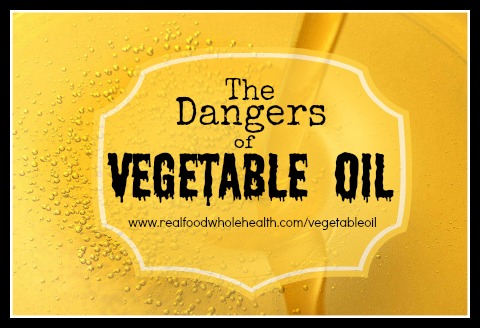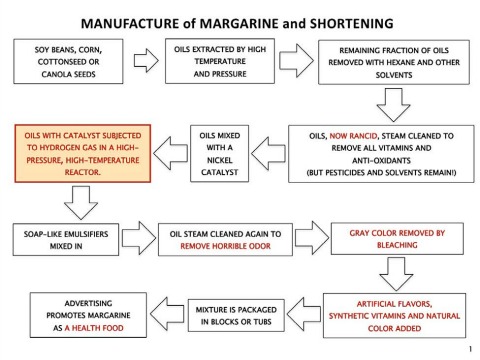
In addition to the problems with industrially processed vegetable oils containing genetically modified organisms, GMOs they are also highly processed, refined and rancid (oxidized).
Read what Sally Fallon has to say about industrial vegetable oils, from her must-read article, “Dirty Secrets of the Food Processing Industry” :
The food processing empire is built on industrial fats and oils, extracted from corn, soybeans and other seeds. Crude vegetable oil–which is dark, sticky and smelly–is subjected to horrendous processing to produce clean-looking cooking oils, margarine, shortening and spreads. The steps involved in processing usually include degumming, bleaching, deodorizing, filtering and removing saturates to make the oils more liquid.In the process, the nutrients and antioxidants disappear–but not the pesticides. Most processors also add a hexane solvent in order to squeeze the very last drop of oil out of the seeds. Caustic refining, the most widely used process for oil refining, involves adding very alkaline, chemicals to the oil.
In order to make a solid fat out of liquid oil, manufacturers subject the oils to a process called partial hydrogenation. The oil is extracted under high temperature and pressure, and the remaining fraction of oil is removed with hexane solvents. Manufacturers then steam clean the oils, a process that removes all the vitamins and all the antioxidants—but, of course, the solvents and the pesticides remain. These oils are mixed with a nickel catalyst and then, under high temperature and pressure, they are flooded with hydrogen gas. What goes into the reactor is a liquid oil; what comes out of that reactor is a smelly mass resembling grey cottage cheese. Emulsifiers are mixed in to smooth out the lumps, and the oil is then steam cleaned once more, to get rid of the horrible smell. The next step is bleaching, to get rid of the grey color. At this point, the product can be called “pure vegetable shortening.” To make margarines and spreads, artificial flavors and synthetic vitamins are added. But the government does not allow the industry to add synthetic color to margarine–they must add a natural color, such as annatto–a comforting thought. The margarine or spread is then packaged in blocks and tubs and advertised as a health food.
 Saturated fat is the type of fat found in such foods as lard, butter and coconut oil. Saturated fat molecules are straight, so they pack together easily. That is why saturated fats are solid at room temperature. Unsaturated fats have a little bend at each double bond, with two hydrogen atoms sticking out on the same side. And when that molecule gets incorporated into your cells, the body wants those two hydrogen atoms to be on the same side of the carbon chain, forming an electron cloud; that is where controlled chemical interactions take place.
Saturated fat is the type of fat found in such foods as lard, butter and coconut oil. Saturated fat molecules are straight, so they pack together easily. That is why saturated fats are solid at room temperature. Unsaturated fats have a little bend at each double bond, with two hydrogen atoms sticking out on the same side. And when that molecule gets incorporated into your cells, the body wants those two hydrogen atoms to be on the same side of the carbon chain, forming an electron cloud; that is where controlled chemical interactions take place.
During the process of partial hydrogenation, one of those hydrogen atoms is moved to the other side, causing the molecule to straighten out so that it behaves chemically like a saturate—although biochemically it behaves very differently. The original, unsaturated molecule is called a “cis” fatty acid, because the two hydrogens are together, and then it becomes a trans fatty acid, because the two hydrogens are across from each other (“trans” means “across”). Your body doesn’t know that this new molecule is something that has never existed in nature before, and when you eat one of these trans fatty acids, it gets built into your cell membranes. Because of the chemical rearrangement, the reactions that should happen can’t take place. Enzymes and receptors don’t work anymore. The more trans fatty acids that you eat, the more partially hydrogenated your cells become and the more chaos that you are going to have on the cellular level.
All of the margarines, shortenings and even low-trans-fat spreads are made with these harmful ingredients. They’re used in chips and crackers, and most restaurants use them for cooking fries. Until the early 1980s, fast food outlets and restaurants cooked the fries in tallow, which is a very safe fat, but now they use partially hydrogenated soybean oil.
In the past, when you made desserts for your kids, at least the sugar they contained came with butter, eggs, cream and nuts—all good wholesome foods. Now manufacturers can imitate the butter, eggs, cream and nuts, so all you have is sugar, industrial oils and artificial ingredients in these instant puddings, pastries and other artificial desserts.
Many diseases have been associated with the consumption of trans fatty acids—heart disease, cancer, and degeneration of joints and tendons. The only reason that we are eating this stuff is because we have been told that the competing saturated fats and oils—butter, lard, coconut oil, palm oil, tallow and suet—are bad for us and cause heart disease. Such assertions are nothing but industry propaganda.
So what should you eat instead of dangerous, rancid, GMO laden vegetable oils? Healthy, traditional fats.
That means:
Tropical Oils (organic, unrefined forms are best)
Coconut
Palm (sustainably sourced only)
Animal Fats (from pastured/grass-fed, organic sources)
Butter or Ghee
Lard (pig fat)
Tallow (beef fat)
Schmaltz (chicken fat)
Duck fat
Full fat dairy
Fat found in pastured meats, eggs
High-fat seafood (wild caught)
Healthy Oils from Vegetable Sources
organic, extra virgin, cold-pressed
olive oil (can be used at low to medium heat for light sauteeing)
sesame oil
flaxseed oil (in very small amounts)
avocado
nut oils (walnut, pecan, macadamia)
nuts & seeds (including nut & seed butters)
AVOID THESE OILS:
canola oil
corn oil
cottonseed oil
vegetable blend oil
soybean oil
safflower oil
grapeseed oil
sunflower oil
rice bran oil
margarine and other “buttery” spreads
hydrogenated or partially hydrogenated oils
trans-fats


What an interesting resume! My wife and I user EV Olive oil for most cooking – at low to medium temperatures, as recommended. there is now a ‘push’ to persuade people in the UK to use Rapeseed oil, from this cabbage family plant grown widely here. Judging from various chef’s blogs this oil is described as having a flavour varying from ‘nutty’ to ‘cabbagey’! Albeit that it ‘smokes’ at a higher temperature than most other oils. Having read your article we will continue with our regular practices ie., using and enjoying butter, lard and Olive Oil. My wife’s father shunned margarines of all descriptions, lunched on bread and dripping (beef fat) and lived to the age of 89!!
What an interesting resume! My wife and I user EV Olive oil for most cooking – at low to medium temperatures, as recommended. there is now a ‘push’ to persuade people in the UK to use Rapeseed oil, from this cabbage family plant grown widely here. Judging from various chef’s blogs this oil is described as having a flavour varying from ‘nutty’ to ‘cabbagey’! Albeit that it ‘smokes’ at a higher temperature than most other oils. Having read your article we will continue with our regular practices ie., using and enjoying butter, lard and Olive Oil. My wife’s father shunned margarines of all descriptions, lunched on bread and dripping (beef fat) and lived to the age of 89!!
Olive oil is wonderful! However, it isn’t suitable for all cooking methods. If olive oil is heated to its smoking point (which will happen if grilling or sautéing over med-high to high heat), the beneficial compounds in it start to degrade and potentially health harming ones form. Organic canola oil is a good choice for high heat cooking and grilling.
You are correct about the olive oil- and we do not recommend heating olive oil beyond a light saute 🙂 However, we do not recommend using canola oil due to its highly processed (and rancid) state. Even organic, cold-pressed canola oil is still too high in Omega-6 to be a considered a health food. We recommend the more healthy saturated fats- like lard from pastured pigs, tallow from grassfed cows- for high heat cooking. Coconut oil and ghee can also take some pretty good heat, as can duck fat.
Olive oil is wonderful! However, it isn’t suitable for all cooking methods. If olive oil is heated to its smoking point (which will happen if grilling or sautéing over med-high to high heat), the beneficial compounds in it start to degrade and potentially health harming ones form. Organic canola oil is a good choice for high heat cooking and grilling.
You are correct about the olive oil- and we do not recommend heating olive oil beyond a light saute 🙂 However, we do not recommend using canola oil due to its highly processed (and rancid) state. Even organic, cold-pressed canola oil is still too high in Omega-6 to be a considered a health food. We recommend the more healthy saturated fats- like lard from pastured pigs, tallow from grassfed cows- for high heat cooking. Coconut oil and ghee can also take some pretty good heat, as can duck fat.
I only use coconut oil and coconut milk. I have a disease called RSD, Reflex Sympathetic Dystrophy, that disturbs the entire nervous system, brain, really everything is affected. Got it just by having a minimal bicep tendon tear repair x2. I’ve shaped up my diet and exercise. No pork or shellfish, minimal red meat. Mostly turkey and chicken. I get the good stuff, because my spouse is in the meat and grocery industry. Eat good, feel good. I’m lucky to have treatments that allow me to exercise, be in the cold, and have no outward signs of the disease. Thanks for taking the time to read this.
Sylvia
I only use coconut oil and coconut milk. I have a disease called RSD, Reflex Sympathetic Dystrophy, that disturbs the entire nervous system, brain, really everything is affected. Got it just by having a minimal bicep tendon tear repair x2. I’ve shaped up my diet and exercise. No pork or shellfish, minimal red meat. Mostly turkey and chicken. I get the good stuff, because my spouse is in the meat and grocery industry. Eat good, feel good. I’m lucky to have treatments that allow me to exercise, be in the cold, and have no outward signs of the disease. Thanks for taking the time to read this.
Sylvia
Great info on trans fats…So few people understand the dangers of this…GMOs are understood even less. Soy is a GMO product yet many believe this is a “healthy food”
Great info on trans fats…So few people understand the dangers of this…GMOs are understood even less. Soy is a GMO product yet many believe this is a “healthy food”
Question- why is peanut oil bad?
Question- why is peanut oil bad?